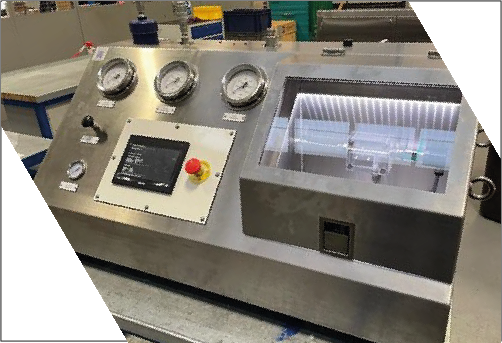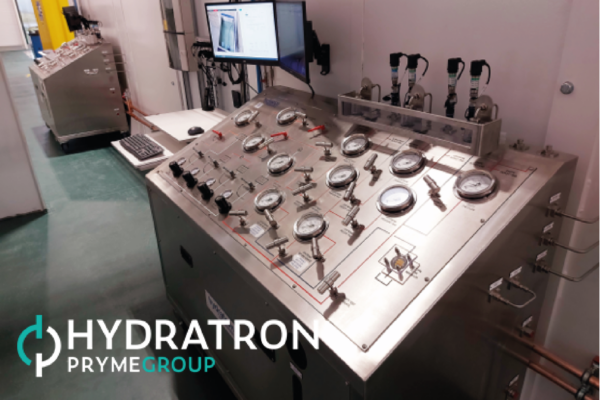
Designed for a well known sealless pump manufacturer and is suitable for carrying out hydrostatic body shell testing of pump casings, bearing housings, coupling housings and casing plates.
The Hydratron 3 Station Sealless Pump Casing/Shroud Pressure Test Rig has been designed for a well known sealless pump manufacturer and is suitable for carrying out hydrostatic body shell testing of four items (pump casings, bearing housings, coupling housings and casing plates) simultaneously at pressures up to 285 bar using water (containing a surfactant) as the test medium. It is also configured such that individual items can also be tested.
The rig has three equally sized test compartments each measuring 82 cm wide x 110 cm deep x 110 cm high located to the right of the control panel. Each of the test compartments has a sliding cover guard open at the top and complete with a ‘Makrolon’ or equivalent safety glass window in the front. The guards are mounted upon ‘Rollon’ slide ways and are moved sideways to allow test compartment access by simply pulling the handle attached to each cover guard.
Having an open top allows for loading/unloading of large/heavy test items by overhead crane or forklift truck.
Key Features
- Test pressures up to 285 bar,
- 82 cm wide x 110 cm deep x 110 cm high test compartments,
- Pressure testing is generally in accordance with BS EN 13445 or PD 5500,
- Can test multiple items at varying pressures at the same time,
- Test fluids can be reused after test cycles complete,
- Overall dimensions of the rig are: 360 cm x 110 cm x 200 cm high,
- All components are tested for a minimum time of 30 min. at ambient temperature and within a range of 5°C and 50°C.
The two internal side walls separating the test compartments are adjustable from side to side to allow longer items to be tested. These are fitted with ‘Makrolon’ or equivalent safety glass windows and are mounted upon ‘Rollon’ slide ways. These internal side walls can be locked in any position to suit the size of item to be tested. They are also moved sideways by simply lifting the locking plate and then pulling on the attached handle.
Due to the various types and sizes of items the rig is capable of testing, any porting or other openings are closed off by the customer using his own plugs and/or blanking flanges etc.
Pressure Test System
The pressure test system is PLC controlled and allows one item to be tested whilst a second, then a third item are loaded into the test compartments and manually pre-filled with test fluid via a hose and lance. Once the test items are pre-filled, any porting or other openings are closed off by the customer using his own plugs and/or blanking flanges etc. The test item is then connected up to the test system via suitably rated hoses in readiness for the pressure test sequence to be initiated.
Each of the test systems comprises of an air driven pump along with all associated valves, controls and instrumentation to allow each item to be tested individually.
The test sequence is initiated by pressing the start button on the PLC HMI. At this stage the data logging system can be started up if required.
Due to the nature of these items, the pressure slowly builds up to 50% of the maximum required and is accurately controlled such that it is not allowed to exceed this limit, but can be within a tolerance of -5%. The pressure is then held at this level for a predetermined time before it is raised to 60% of the maximum.
Again, the pressure is accurately controlled such that it is not allowed to exceed this limit, but can be within a tolerance of -5%. The pressure is then held at this level for a predetermined time before it is raised to 70% of the maximum and so on until the item has been tested to it’s maximum pressure. At no stage in the test sequence must the set pressure be outside of the set limits during the set time.
General
- All instrumentation and controls in everyday use are mounted on a stainless steel engraved and colour coded control panel situated at a convenient working height for easy operation.
- The rig is provided with forklift truck pockets to facilitate easy loading/unloading and is sufficiently robust to take the weight of three of the largest and heaviest items under test condition.
- There is also the facility to be able to test manually in one test compartment if required.



